
Heirloom Apple Trees for your New England Homestead
Our Trees are grown on full standard root stock to availd the deer browsing that is a problem in our area - and maybe in yours.
Trees are two-year tops from 5 to 8 feet tall in 7 gallon fiber bags.
Price $100
| Variety | Description | Availability |
|---|---|---|
| 20 Ounce | Very Large baking apple originating in Cayuga County, New York in the early 1800s. | Fall of 2026 |
| Aroostook Sunset | All-around eating and cooking apple discovered in Fort Fairfield, Maine. Very cold-hardy. | Fall of 2025 |
| Baldwin | Great eating, cooking, and cider apple originating in Lowell, MA in the 1740s. It was one of the most popular orchard apples in the mid-1800s. | Fall of 2026 |
| Yellow Bellflower | Yellow skinned cooking and cider apple that originated in Crosswicks, NJ in the early 1700s. | Fall of 2025 |
| Black Oxford | A favorite dessert, cider, and cooking apple. Originated in Oxford County, Maine around 1870. Keeps up to 4 months and gets sweeter in storage. | Fall of 2026 |
| Chenango Strawberry | Excellent eating apple that is also good for sauce and pies. Vigorous grower that needs regular pruning. Fruit has a long, conical shape. Originated in central New York in the early 1800s. | Fall of 2025 |
| Cortland | A popular supermarket apple, bears annually and is very winter hardy. Was developed by the Cornell Experimental Station in Genava, New York as a cross between McIntosh and Ben Davis in 1898. | Fall of 2025 |
| Cox Orange Pippin | One of the finest dessert apples for fresh eating. Keeps well. Developed by a botanist in Buckinghamshire, UK in 1825. Well-suited to espalier training. | Fall of 2026 |
| Dutchess of Oldenberg | An early bearer (mid-August in Tenants Harbor) with heavy crops almost every year. Best eaten right off the tree, as the fruit does not keep well. Originated in Russia in the late 1700s. | Fall of 2027 |
| Ginger Gold | Small to medium round, conic, yellow apple with great flavor. Bears early and keeps well. Originated in the Blue Ridge Mountains in the early 1970s. | Fall of 2026 |
| Gravenstein | A very hardy cooking and cider apple. Vigorous grower and bears relatively early in the season. Originated in Europe in the late 1600s. | Fall of 2026 |
| Lamb Abbey | A small but very sweet dessert apple. Keeps well in cold storage. Originated in Kent, UK in the very early 1800s. | Fall of 2026 |
| Liberty | Medium to large round red apple that ripens relatively late. Good for fresh eating or cooking. Bred for disease resistance and introduced in New York in 1974. | Fall of 2025 |
| McIntosh | A very popular supermarket apple. Medium to large red fruit are great for eating or cooking. Discovered by John McIntosh (a British loyalist that fled to Ontario in the late 1700s.) One of the most popular New England orchard apples. | Fall of 2025 |
| Paula Red | Similar to McIntosh in size and shape. Fruit ripens earlier and should be eaten within a couple of weeks. Identified from a McIntosh seedling in Sparta, MI and introduced in the late 1960s. | Fall of 2026 |
| Red Astrichan | Round, red, fruit with great flavor bears early in the season. Flesh is sometimes tinged red. Great for fresh eating, pies, sauce, cider. Originated along the lower Volga river in Russia in the 1780s. | Fall of 2027 |
| Redfree | Medium to large red summer apple. Bred for disease resistance at Rutgers University. Released in 1981. | Fall of 2026 |
| Russel’s Russet | Excellent fall eating apple, if not the prettiest apple in the world. Selected from a wild seedling by John Butler in 1999. | Fall of 2026 |
| Shavel Sharp | A very sharp cider apple to add character to your cider pressing. | Fall of 2026 |
| Wealthy | Very good cooking and cider apple. Selected for the hard winters in Minnesota. Released in 1893. | Fall of 2026 |
| Wolf River | Very large cooking apple that bears late in the season. Apple holds its shape when baked and makes great pies. Originated in Freemont, WI in the 1860s. | Fall of 2025 |